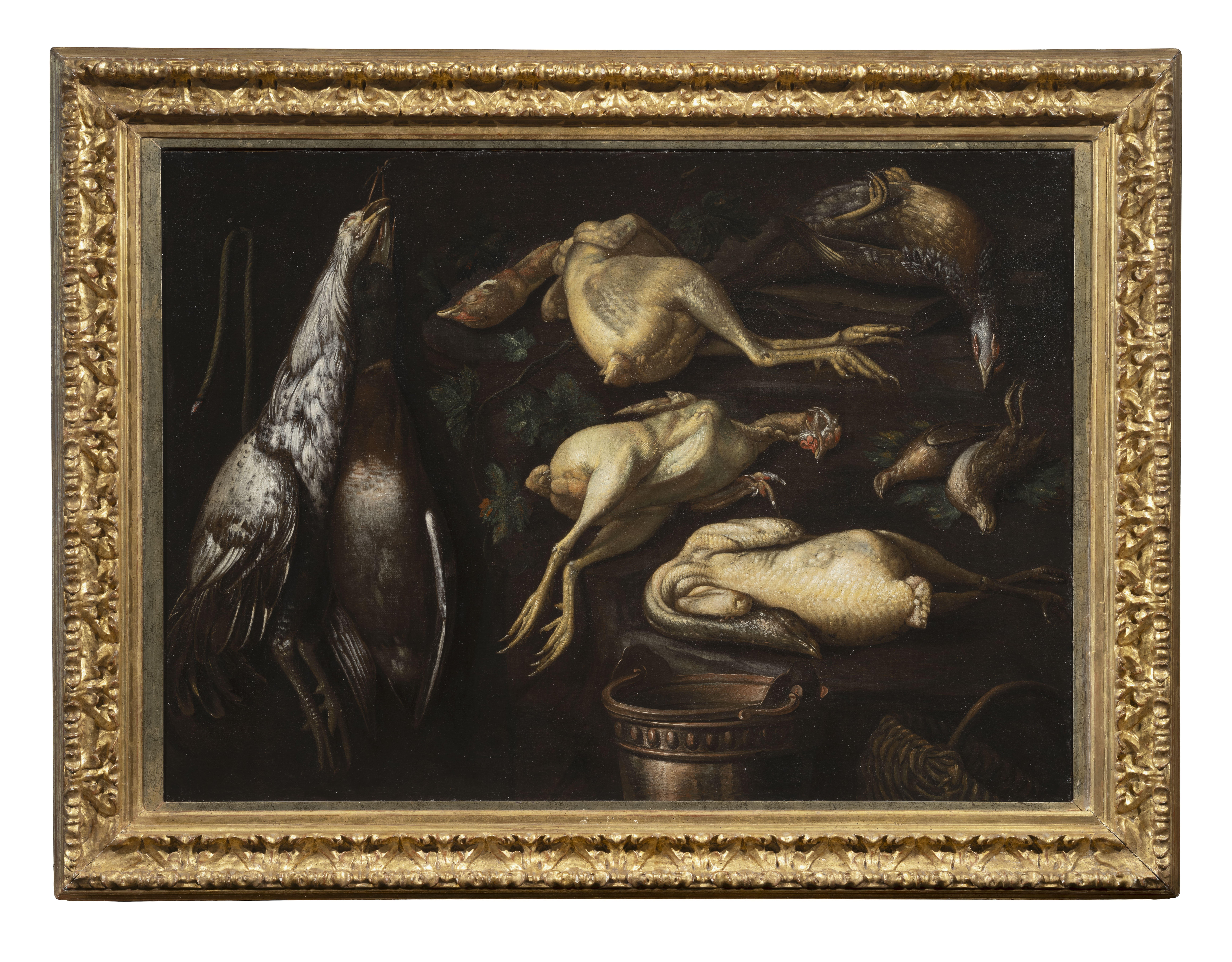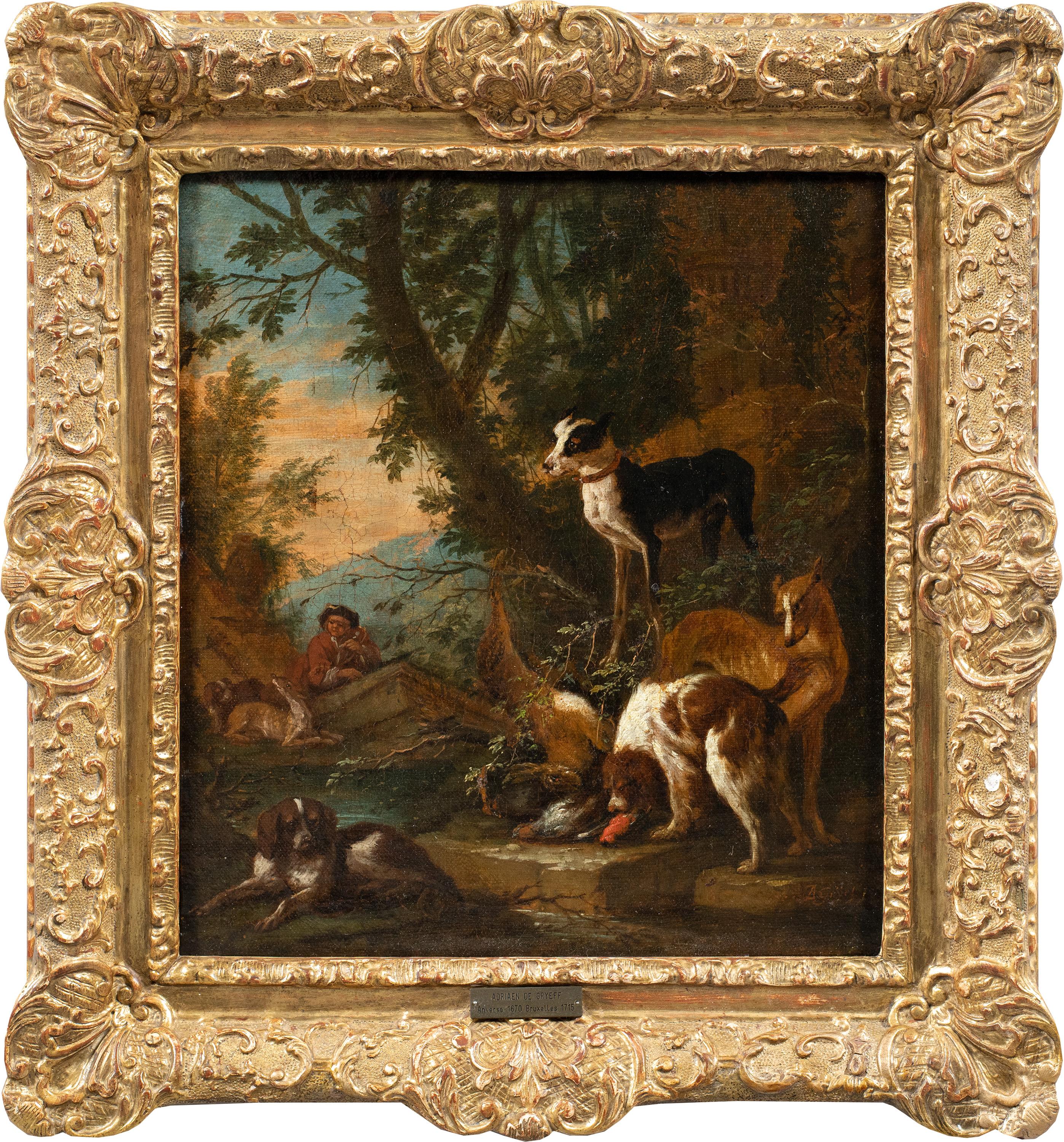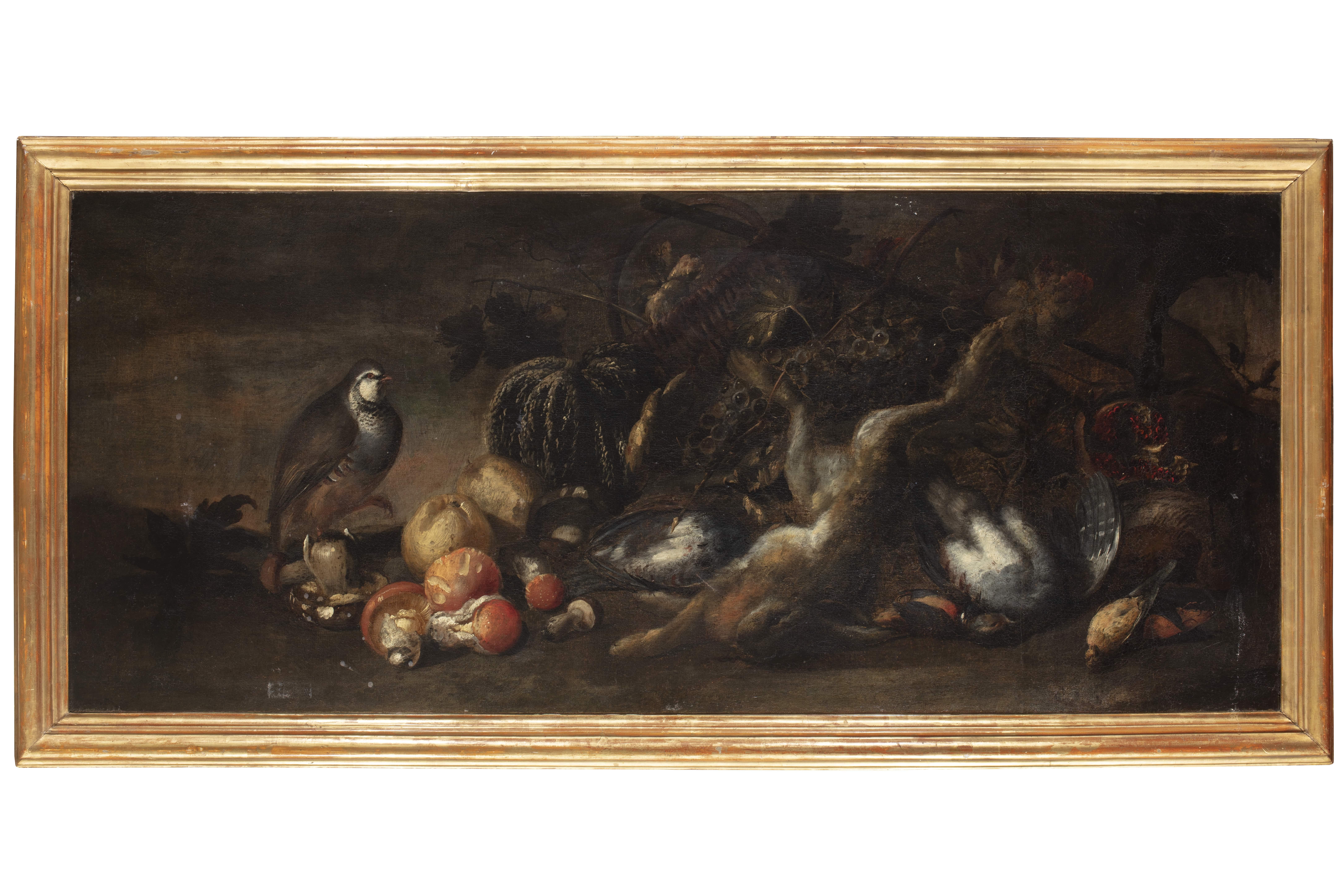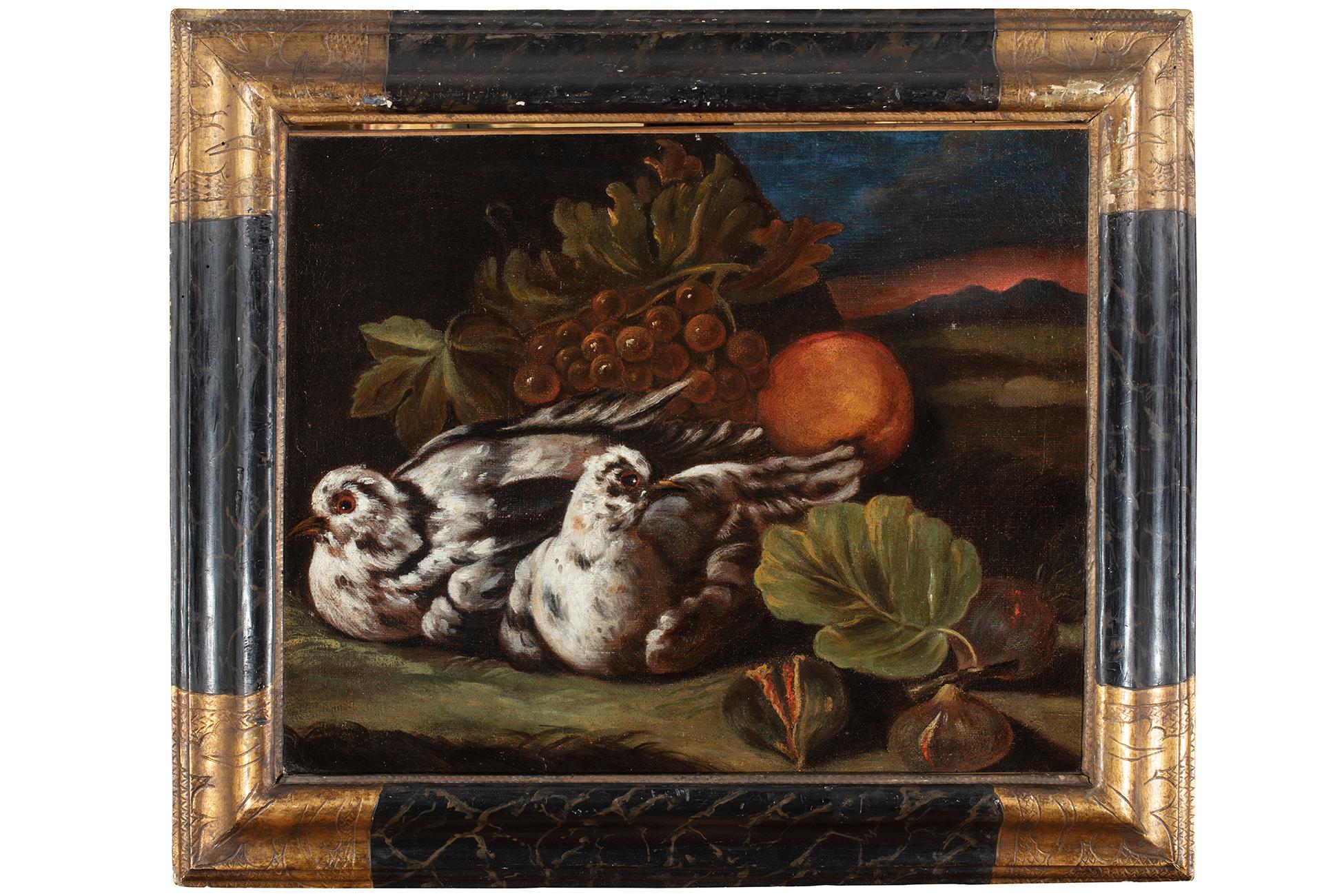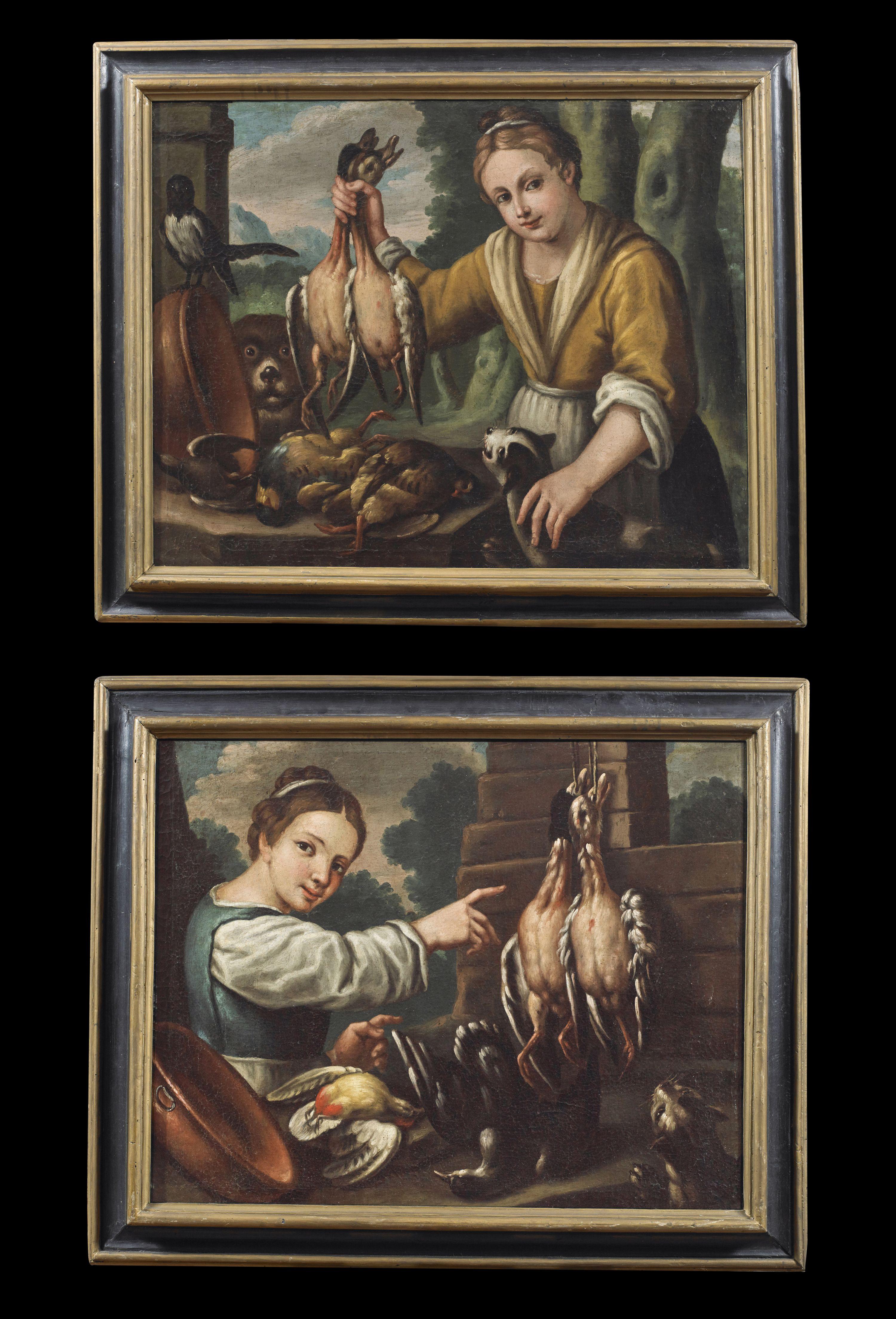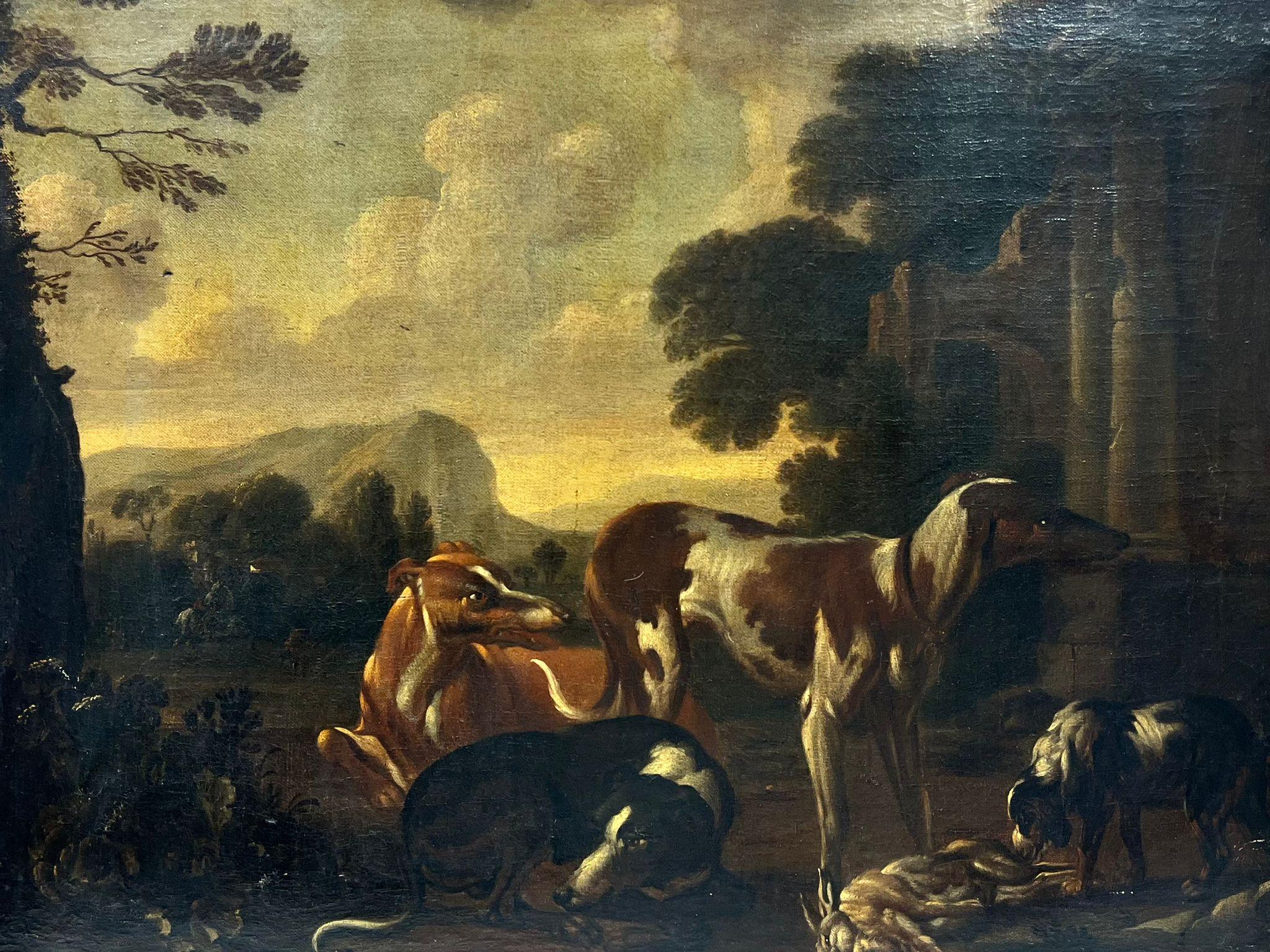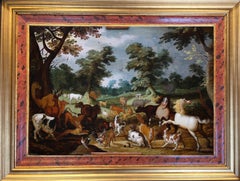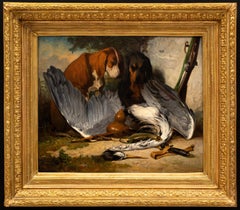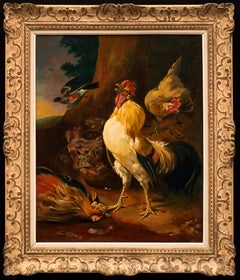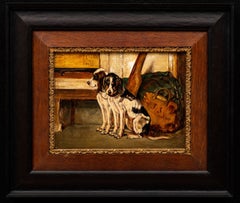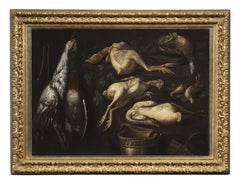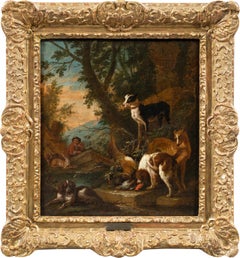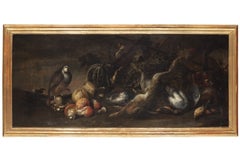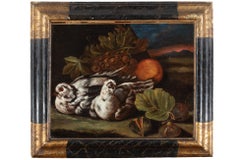Items Similar to Still Life of Spaniels and Falcons in Landscape Setting by Carstian Luyckx
Want more images or videos?
Request additional images or videos from the seller
1 of 16
Carstian Luyckx (1627-1675 circa)Still Life of Spaniels and Falcons in Landscape Setting by Carstian LuyckxCirca 1670
Circa 1670
$375,000
£286,463.05
€329,117.15
CA$536,169.38
A$590,733.77
CHF 305,799.57
MX$7,112,587.50
NOK 3,872,162.25
SEK 3,637,651.50
DKK 2,457,486
About the Item
Still Life of Game with Dogs and Spaniels in a Landscape Setting
Carstian Luyckx (Flemish, 1623 – c.1675)
Oil on canvas
Circa 1670
Unsigned
43 ½ x 59 1/8 in.; Frame 52 7/8 x 68 7/8 in. (110,4 X 150,2 cm.; Frame: 134,4 X 174,9 cm.)
Provenance:
Didier Aaron Gallery in Paris, with an erroneous attribution to Philip Ferdinand de Hamilton (Flemish, 1664-1750)
We are grateful to Dr. Fred Meijer who has confirmed our attribution in full.
This spectacular picture was painted by the Antwerp animal and still life painter Carstian Luyckx (1623 – c.1675). Though scarcely known to the general public today, this versatile artist was very successful and held in high regard in seventeenth-century Antwerp. The sport of hunting falconry, practiced since ancient times, was a pursuit particularly enjoyed at medieval and renaissance courts. The larger gyrfalcon and peregrine falcons depicted here are beautifully rendered likenesses: Luyckx's prowess is on full display, particularly in the way he balances light and texture to capture the varied intricacies of the colors throughout the canvas. This lively and resplendent scene, combined with the directness of Luyckx’s style, produces a truly spectacular image, which is therefore one of his most attractive works.
Carstian Luyckx. also known as the Monogrammist KL, was a Flemish painter and draughtsman was born in Antwerp. From 1639 to March 1642 Luyckx was apprenticed to Philips de Marlier, a Flemish painter and draughtsman who had relocated to Antwerp. During this period, Luyckx had become specialized in still life paintings in all their forms: vases, vanitas, banquets, festoons of flowers, fruit bowls, garland flower still lifes and, pronkstillevens (sumptuous still lifes). Three years later Luyckx transferred to the studio of Frans Francken III, who worked in other genres besides flower still lifes and could therefore train the young man in a wider range of skills.
Luyckx travelled to Lyon in 1644 at 21 years of age, returning a year later to marry. In 1645 he finally enrolled in the St Luke’s Guild in Antwerp, acquiring the right to work as an independent master. His career immediately soared, attaining the rank of master on 17 July 1645. In 1646, he appears documented as a painter to the King of Spain in a record held in the town of Antwerp.
The formal characteristics Luyckx employed are based on those of Jan Fyt, although on occasions, his works are closer in style to that of Jan Davidsz. de Heem. He additionally worked in collaboration with other artists: for instance, with David Teniers II, exemplified by their work Garland with Chronos (Lazienki Palace in Warsaw), as well as with Nicolaes van Verendael. The style of his floral still lifes demonstrates the influence of Daniel Seghers’s work, as well. He often produced funeral wreaths, the most famous of which was for the painter Victor Wolfveot in 1652.
It is believed that he left Antwerp and worked in France as many of his later works carry French inscriptions. During his residence in France, Luyckx influenced other vanitas painters, including Simon Renard de St. André. It is not clear when and where Luyckx died but his death date is assumed to be in the years of 1677-1678.
Pronkstillevens
A large portion of Luyckx output consists of pronkstillevens (“pronks”), the sumptuous still lifes that were popular in Flanders and the Dutch Republic from the 1640s. Luyckx’ work in this genre was influenced by the artist Jan Davidsz. de Heem who was active in both Antwerp and the Dutch Republic. A representative example in this genre is the Opulent Still-Life with Silver and Gilt Metal Objects, Nautilus Shell, Porcelain, Food and Other Motifs on a Draped Table at the Montreal Museum of Fine Arts. This work dates from about 1650 and is painted on copper.
Vanitas
Luyckx was especially known for his vanitas still lifes, a genre of still lifes which are intended as a reflection on the meaninglessness of earthly life and the transient nature of all earthly goods and pursuits. He had followers in France such as Simon Renard de St. André and vanitas works by Luyckx have in the past been attributed to these artists. This is for instance the case with the composition Vanitas Still Life with a Skull, a Violin, a Musical Score, a Pipe and Tobacco, an Hourglass and a Candle on a Draped Table (Sold at Sotheby's on 6 December 2012 in London, lot 201) previously given to St. André. This composition shows a musical score, which contains a single vocal part of a religious Latin choral composition, the text of which specifically relates to death. The inscription on the musical score probably refers to the 16th-century composer Orlande de Lassus
Hunting pieces and animals
His hunting pieces (game still lifes) were influenced by the Flemish specialists in this genre Frans Snyders and especially Jan Fyt. An example of his hunting pieces is A Hunting Still Life of Partridges with Four Springer Spaniels, a Hawk, a Gamebag and Belt and Other Hunting Gear in a Landscape (Sold at Christie's on 20–21 November 2013 in Amsterdam, lot 168). This work is believed to date to the transitional phase between Luyckx’ Antwerp and French periods in the 1650s.
Luyckx painted compositions with life animals. A good example of this is the Fowl Attacked by a Fox (The Kremer Collection). This composition gives a lively rendering of a fox catching a chicken amidst a group of fowl. The artist has aptly observed the startled reaction of the rooster nearest to the fox. The other fowl appear unaware of the danger that they are in. The chicken that is being grabbed stares at the viewer more in surprise than in fear.
Other works featuring poultry have been attributed to Luyckx, but these generally focus on fowl that have been shot in a landscape, frequently guarded by a hunting-dog. Luyckx also often included dogs and cats in his numerous still lifes with fruit and the spoils of hunting, something he had in common with Fyt and Snijders. Yet for all the presence of live animals, these images are relatively static in contrast to the drama and dynamism of our Falcons and Spaniels Guarding the Spoils of the Hunt
Falconry in the 17th century
Basis for the noble sport of hunting was the following adage: “fur against fur, plumes against plumes”. This meant that dogs would hunt for running animals such as deer, boars and hares, while birds would catch birds. In Flanders the Spanish Habsburg archdukes Albert and Isabella prohibited in a decree of 1613 the use of guns, nets and other mechanical devises to support this vision of the hunt. But a simple decree could of course not stop the popularity of firearms, not even at their own court.
There were two types of falconry for hunting wildfowl:
- in the spectacular so-called high flight falcons dive onto their prey, in particular herons.
- in the so-called low flight hawks and sparrow hawks use a horizontal attacking technique.
Arendonk in Flanders and Valkenswaard in Holland were the main centers of falconry.
Peregrines were caught locally though the white gyrfalcons came from as far as Scandinavia and Iceland; they could cost more than a noble racehorse. Both species were trained for hunting.
The hunting season ran from June 24th until November 11th.
The text of Dr. Fred Meijer (08/04/2025):
“I fully agree with your attribution of this work to Carstian Luyckx, as a late work, (well) after circa 1660. I already attributed it to him in 2002.
Luyckx was indeed born in Antwerp in 1623 but most likely did not die there. He disappeared from Antwerp in or after 1658, and much of his later work (judging by French inscriptions and the French-phonetic spelling of his signature as K. Lux) most likely originated in France, where he presumably worked for at least another decade, but probably longer. A variant of this composition was auctioned in 2013 by Joron Derem as De Gryef.”
- Creator:Carstian Luyckx (1627-1675 circa) (Dutch)
- Creation Year:Circa 1670
- Dimensions:Height: 52.88 in (134.32 cm)Width: 68.88 in (174.96 cm)
- Medium:
- Movement & Style:
- Period:1660-1669
- Condition:The painting is in very good condition and beautifully framed. The presence that the painting presents is simply astounding. Ultraviolet light photographs and Mr. Meijer's letter of authentication are available upon request.
- Gallery Location:SANTA FE, NM
- Reference Number:1stDibs: LU1408216827322
About the Seller
5.0
Platinum Seller
Premium sellers with a 4.7+ rating and 24-hour response times
Established in 1995
1stDibs seller since 2020
123 sales on 1stDibs
Typical response time: 1 hour
- ShippingRetrieving quote...Shipping from: Santa Fe, NM
- Return Policy
Authenticity Guarantee
In the unlikely event there’s an issue with an item’s authenticity, contact us within 1 year for a full refund. DetailsMoney-Back Guarantee
If your item is not as described, is damaged in transit, or does not arrive, contact us within 7 days for a full refund. Details24-Hour Cancellation
You have a 24-hour grace period in which to reconsider your purchase, with no questions asked.Vetted Professional Sellers
Our world-class sellers must adhere to strict standards for service and quality, maintaining the integrity of our listings.Price-Match Guarantee
If you find that a seller listed the same item for a lower price elsewhere, we’ll match it.Trusted Global Delivery
Our best-in-class carrier network provides specialized shipping options worldwide, including custom delivery.More From This Seller
View All"Earthly Paradise" Frédérick Bouttats (Antwerp, 1590-1661)- Studio of
Located in SANTA FE, NM
The Earthly Paradise
Frédérick Bouttats (Antwerp, 1590-1661)
Painting is Circa 1610-1612
Oil on wood panel, circa 42 7/8 x 29 3/8 (ca. 52 x 39 frame) inches
The inner frame is c18th ...
Category
1610s Old Masters Animal Paintings
Materials
Oil, Wood Panel
"Still Life and Hunting Dogs, 1851" P. M. Guillemin (French, 1800-1874)
Located in SANTA FE, NM
"Still Life and Hunting Dogs, 1851"
P. M. Guillemin (French, 1800-1874)
Monogrammed "EG" on right side.
Oil on cradle board
26 x 21 (36 x 31 frame) inches
Stunning example and un...
Category
1850s Romantic Animal Paintings
Materials
Oil, Wood Panel
"A Triumphant Cockerel Crowing Over His Victory" Melchior Hondecoeter (after)
Located in SANTA FE, NM
"The Victor (A Triumphant Cockerel Crowing Over His Victory...)"
After Melchior de Hondecoeter (Flemish, 1636-1695)
Oil on canvas
Unsigned
40 1/2 x 34 1/4 (frame) inches
This much copied painting is a masterfully executed portrait of a strutting and triumphant rooster painted...
Category
Early 1900s Old Masters Animal Paintings
Materials
Canvas, Oil
Pair of Hunting Dogs at Rest; artist unknown, French, Mid-19th century
Located in SANTA FE, NM
Pair of Hunting Dogs at Rest;
Artist unknown, French, 19th century (monogrammed "JS"
Circa 1850
10 x 7 (14 3/8 x 17 1/8 frame) inches
This is finely realized portrait of pair of h...
Category
1830s Romantic Animal Paintings
Materials
Oil, Wood Panel
Dog Portrait of a Hunting Dog by Jules Chardigny (1849-1892)
Located in SANTA FE, NM
Antique Dog Painting of a Hunting Dog
Jules Chardigny (1849-1892)
Circa 1870
Oil on paper.
8 x 6 (18 1/2 x 15 1/4 frame) inches
In Jules Chardigny's signature style, a beloved compa...
Category
1860s Realist Animal Paintings
Materials
Oil, Laid Paper
Large Dog Portrait: Grand Griffon Vendéen Hunting Dogs Jules Chardigny
Located in SANTA FE, NM
Double Portrait: Grand Griffon Vendéen Hunting Dogs
Jules Chardigny (France, 1842-1892) circa 1870
Oil on canvas, signed
21 3/4 x 18 1/4 (29 1/8 x 25 frame) inches
Though pairs of G...
Category
1870s Realist Animal Paintings
Materials
Canvas, Oil
You May Also Like
17th Century By Lombard Artist Still Life with Birds and Burning Fuse Oil/canvas
Located in Milano, Lombardia
Lombard Artist of the 17th Century
Title: Still life with birds and burning fuse
Medium: Oil on canvas
Dimensions: without frame 79 x 109 cm - 103 x 136 cm with frame
"Cassetta" fram...
Category
17th Century Old Masters Still-life Paintings
Materials
Canvas, Oil
Adriaen de Grijef (Dutch master) - 17th century figure painting - Hunt scene
Located in Varmo, IT
Adriaen de Grijef (Leiden 1657 - Brussels 1722) - The Return from the Hunt.
40 x 36 cm unframed, 56 x 51 cm with frame.
Oil on panel, in a carved and gilded wooden frame.
- Signed...
Category
Late 17th Century Baroque Landscape Paintings
Materials
Oil, Panel
Late 17th Century By Still-life Italian painter Still life Oil on Canvas
Located in Milano, Lombardia
17th Century Still-life Italian painter
Title: Still life
Medium: Oil on canvas
Dimensions: without frame 58 x 136 cm - with frame 71.5 x 150 cm
Antique shaped and gilded wooden box...
Category
17th Century Old Masters Still-life Paintings
Materials
Oil, Canvas
17th Century by Onofrio Loth Still Life Oil on Canvas
Located in Milano, Lombardia
Onofrio Loth (Naples, Italy, 1665 – 1717)
Title: Still life
Medium: Oil on canvas
Dimensions: without frame 37.5 x 47.5 cm – with frame 50 x 57 cm
Original ebonised wooden frame wit...
Category
Late 17th Century Old Masters Still-life Paintings
Materials
Cotton Canvas, Oil, Canvas
$11,995 Sale Price
20% Off
17th Century Still Life Felice Boselli Natura Morta Animals Oil on Canvas Yellow
By Felice Boselli
Located in Sanremo, IT
Pair of paintings, still on the first canvas, oil on canvas measuring 70 x 82 cm without frame and 80 x 92 cm with coeval frame by the painter Felice Boselli (Piacenza 1650 - Parma 1732) depicting a still life with popular characters, animals and game.
Felice Boselli was an Italian painter of the Baroque period, best known for still lifes of game...
Category
Late 17th Century Italian School Animal Paintings
Materials
Canvas, Oil
Fine 1700's Italian Old Master Oil Painting Hunting Dogs with Game, Roman Ruins
Located in Cirencester, Gloucestershire
Artist/ School: Italian School, early 18th century
The painting is almost certainly from the circle of the Italian Baroque painter known as 'Rosa da Napoli', Jacob Roos (Rome 1682-Na...
Category
Early 18th Century Baroque Landscape Paintings
Materials
Oil
$5,992 Sale Price
20% Off
